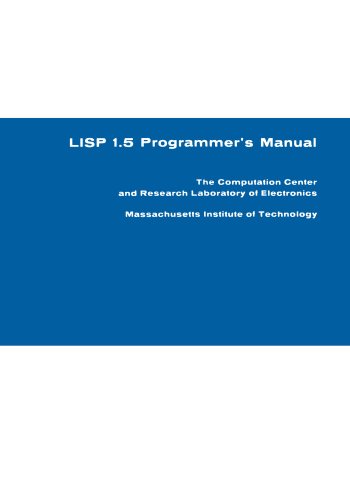
LISP 1.5 Programmer's Manual
by John McCarthy
Publisher: The MIT Press 1985
ISBN/ASIN: 0262130114
Number of pages: 116
Description:
The LISP language is designed primarily for symbolic data processing used for symbolic calculations in differential and integral calculus, electrical circuit theory, mathematical logic, game playing, and other fields of artificial intelligence. The manual describes LISP, a formal mathematical language.
Download or read it online for free here:
Download link
(4.5MB, PDF)
Similar books
 Casting Spells in Lisp
Casting Spells in Lispby Conrad Barski - Lisperati.com
Anyone who has ever learned to program in Lisp will tell you it is very different from any other programming language. It is different in lots of surprising ways- This comic book will let you find out how Lisp's unique design makes it so powerful!
(21352 views)
 Common Lisp: An Interactive Approach
Common Lisp: An Interactive Approachby Stuart Charles Shapiro - W.H. Freeman & Company
The book is a self-paced study guide to Common Lisp programming language. It presents Lisp in a general setting, rather than in the context of a special field in which it is used. The text assumes experience with some imperative programming languages.
(15528 views)
 Common Lisp
Common Lisp- Wikibooks
Common Lisp is a modern, multi-paradigm, high-performance, ANSI-standardized programming language. Contents: First steps; Basic topics; Advanced topics; Beyond ANSI Common Lisp; External libraries; Implementation Issues; Case Studies in CL; etc.
(15080 views)
 Practical Common Lisp
Practical Common Lispby Peter Seibel - Apress
An introduction to Common Lisp for people curious about Lisp and a tutorial for anybody who wants to get down to real coding right away. Learn Lisp from this book and it will make you a better programmer in any language.
(23060 views)